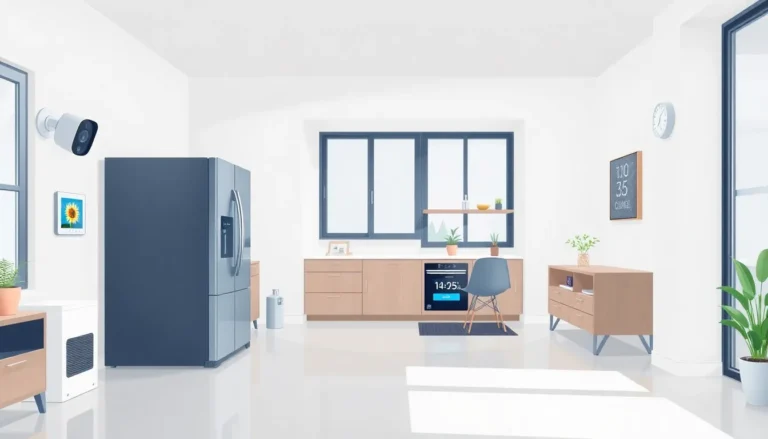Table of Contents
ToggleIn a world where your refrigerator can text you when you’re out of milk, G IoT is the superhero we never knew we needed. Imagine a universe where devices communicate seamlessly, making life easier and a little more entertaining. From smart homes to connected cities, G IoT is transforming the mundane into the extraordinary, one gadget at a time.
But hold onto your smart hats, because this isn’t just about convenience. G IoT is revolutionizing industries, enhancing efficiency, and even helping save the planet. With every connected device, we’re stepping into a future that’s not just smarter but also a lot more fun. So, buckle up as we dive into the fascinating world of G IoT, where technology meets innovation and a dash of humor.
Overview of G IoT
G IoT signifies a major shift in how devices interact and communicate. This technology empowers smart appliances to connect with one another, creating a fully integrated ecosystem. Smart thermostats can adjust settings based on user behavior, enhancing comfort while reducing energy consumption.
Businesses also reap benefits from G IoT. Manufacturing lines equipped with interconnected sensors can monitor machinery in real-time. By providing immediate data, G IoT minimizes downtime and streamlines operations. Retailers utilize this technology to analyze customer preferences, resulting in tailored shopping experiences and optimized inventory management.
Environmental sustainability receives a boost through G IoT applications. Smart energy grids monitor and manage power distribution, reducing waste. Connected water management systems provide alerts for leaks and promote conservation efforts.
G IoT further facilitates health monitoring. Wearable devices track vital signs and health metrics, allowing for more personalized healthcare. Hospitals equipped with G IoT can improve patient outcomes through timely interventions.
Security also sees enhancements with G IoT technology. Home security systems utilize interconnected cameras and sensors to monitor activities, providing users with real-time alerts via mobile applications. Smart locks enable remote access control, ensuring safety and convenience.
G IoT fosters innovation across various sectors. Transportation systems benefit from connected vehicles that enable real-time traffic updates. Communication between vehicles and infrastructure minimizes accidents and improves travel efficiency.
Embracing G IoT transforms not only individual lives but also industries. The future promises even more advancements, blending technology with daily activities while addressing critical challenges faced globally.
Key Features of G IoT

G IoT embodies several key features that significantly improve device interaction and efficiency.
Enhanced Connectivity
G IoT maximizes connectivity across devices, allowing them to communicate seamlessly. Smart home devices integrate with one another, creating a unified user experience. High-speed networks enable real-time data exchange, facilitating instant responses to user commands. With advancements in network technologies, devices like smart thermostats can analyze user habits and adjust settings automatically. Additionally, G IoT supports diverse communication protocols, ensuring compatibility among various devices. Multiple manufacturers often collaborate to enhance interoperability, fostering a more efficient ecosystem. Overall, enhanced connectivity leads to smarter homes and streamlined operations in industries.
Improved Security
G IoT addresses security concerns through advanced measures protecting user data and devices. Devices utilize encryption methods to safeguard information transmitted over networks. In interconnected home systems, real-time alerts notify users of unauthorized access attempts. Surveillance cameras linked through G IoT provide remote monitoring and enhanced peace of mind. Integrating biometric sensors into systems strengthens access control and reduces vulnerabilities. Regular software updates also ensure protection against emerging threats. Consequently, improved security features foster user trust and promote wider adoption of G IoT technologies.
Applications of G IoT
G IoT impacts various sectors significantly, enhancing both personal and industrial operations. The technology fosters efficiency, innovation, and sustainability across different applications.
Smart Homes
Smart homes illustrate G IoT’s potential by integrating technology into daily living. Devices like smart refrigerators alert homeowners about low supplies, while smart thermostats adjust temperatures automatically for comfort. Energy management systems monitor and optimize usage, enabling significant savings. Voice-activated assistants control various appliances seamlessly, enhancing user experience. Security systems offer real-time alerts, improving safety for residents. These advancements not only provide convenience but also promote energy efficiency and sustainability in everyday activities.
Industrial Automation
Industrial automation benefits immensely from G IoT through improved operational efficiency. Factories employ real-time monitoring to track machinery performance, minimizing downtime significantly. Connected sensors collect data on equipment health, enabling predictive maintenance. Supply chains become more efficient as businesses analyze data for optimized logistics. Smart manufacturing processes incorporate automation and robotics, reducing labor costs and increasing productivity. This integration fosters a competitive edge, ensuring that industries meet consumer demands swiftly and effectively.
Challenges Facing G IoT
G IoT faces several challenges that can hinder its widespread adoption and effectiveness. Key concerns include scalability and data privacy.
Scalability Issues
Scalability poses a significant challenge for G IoT. As the number of connected devices increases, infrastructure must support higher data traffic. Network congestion may occur, leading to delays in communication between devices like smart appliances. Furthermore, developing robust systems that can efficiently handle expansive IoT networks becomes essential. Companies often struggle with integrating new devices without disrupting existing operations. Solutions such as cloud computing and edge computing can help manage data flow, but concerns about the associated costs persist.
Data Privacy Concerns
Data privacy remains a critical issue within G IoT ecosystems. Collecting sensitive information from personal devices raises the risk of breaches. User trust becomes eroded when data protection doesn’t meet stringent security standards. Furthermore, regulatory compliance presents hurdles for businesses looking to implement G IoT solutions. Companies must ensure that user data is encrypted and stored securely to prevent unauthorized access. Transparent data usage policies also play a vital role in maintaining consumer confidence. Addressing these privacy concerns is crucial for fostering broader acceptance of G IoT in everyday life.
Future Trends in G IoT
Emerging trends in G IoT focus on enhanced efficiency, security, and integration across various sectors. Machine learning continues improving device interactions, leading to smarter systems that adapt to user behaviors and preferences. Predictive analytics play a crucial role in optimizing operations, enabling industries to anticipate maintenance needs and reduce downtime.
5G technology significantly impacts G IoT by providing high-speed, low-latency connections that support vast numbers of devices. Smart cities benefit from connected sensors and infrastructure, facilitating real-time data collection for efficient resource management. These advancements promote sustainable urban living by optimizing energy usage and reducing waste.
Data security gains attention, as manufacturers implement advanced encryption and privacy measures to protect sensitive information. Zero-trust models are being adopted to ensure that all device communications are secure, fostering user confidence and broader acceptance. Devices are designed with built-in security protocols to minimize vulnerabilities.
Integration of artificial intelligence within G IoT systems enhances data processing capabilities and decision-making. Cloud computing models offer scalable solutions for managing increased data loads from diverse devices. Drones and robots are increasingly utilized in monitoring environments, transforming industries like agriculture and logistics.
Augmented reality and virtual reality applications are on the rise, providing immersive experiences that integrate with connected devices. This new interface allows users to interact with their G IoT devices in intuitive ways, improving engagement. As interconnected networks grow, the potential for collaboration and innovation expands, reshaping industries.
Overall, G IoT is evolving rapidly, creating opportunities for businesses to streamline operations and improve customer experiences. Major shifts in how devices communicate promise revolutionary advancements that will further integrate technology into daily life. Investors and researchers remain focused on future developments, ensuring that G IoT continues transforming industries and enhancing sustainability.
G IoT stands as a pivotal force in reshaping how individuals and industries interact with technology. Its ability to connect devices seamlessly not only enhances convenience but also drives efficiency and sustainability across various sectors.
As G IoT continues to evolve, it opens doors to innovative solutions that address modern challenges. The integration of advanced technologies like machine learning and 5G ensures that the future holds even greater potential for smarter living and operational excellence.
While challenges like data privacy and scalability remain, ongoing advancements promise to enhance user trust and broaden adoption. Embracing G IoT is not just about keeping up with trends; it’s about participating in a transformative journey that enriches everyday life and fosters a more sustainable future.







